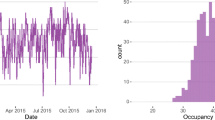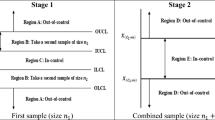Abstract
In this paper, we introduce a new discrete block state-dependent arrival (D-BSDA) distribution which provides fresh insights leading to a successful generalization of the discrete-time Markovian arrival process (D-MAP). The D-BSDA distribution is related to structured Markov chains and the method of stages. The consideration of this new discrete-time state-dependent block description gives one the ability of construct new stochastic models. The retrial queue analyzed in this paper gives an example of application of the D-BSDA distribution to construct more general and sophisticated models. We assume that the primary arrivals and the retrials follow the D-BSDA description and the service times are of discrete phase-type (PH). We study the underlying level dependent Markov chain of M/G/1-type at the epochs immediately after the slot boundaries. To this end, we employ the UL-type RG-factorization which provides an expression for the stationary probabilities. We also perform an analysis of waiting times. Numerical experiments are presented to study the system performance.

Similar content being viewed by others
References
Alfa AS (2006) Discrete-time analysis of the GI/G/1 system with Bernoulli retrials: an algorithmic approach. Ann Oper Res 141:51–66
Allen LJS (2003) An introduction to stochastic processes with applications to biology. Prentice-Hall, Englewood Cliffs
Artalejo JR, Gomez-Corral A (2008) Retrial queueing systems: a computational approach. Springer, Berlin
Artalejo JR, Lopez-Herrero MJ (2007a) On the distribution of the number of retrials. Appl Math Model 31:478–489
Artalejo JR, Lopez-Herrero MJ (2007b) A simulation study of a discrete-time multiserver retrial queue with finite population. J Stat Plan Inference 137:2536–2542
Artalejo JR, Lopez-Herrero MJ (2009) Cellular mobile networks with repeated calls operating in random environment. Comput Oper Res. doi:10.1016/j.cor.2009.01.011
Artalejo JR, Atencia I, Moreno P (2005) A discrete-time Geo [X]/G/1 retrial queue with control of admission. Appl Math Model 29:1100–1120
Artalejo JR, Economou A, Gomez-Corral A (2008) Algorithmic analysis of the Geo/Geo/c retrial queue. Eur J Oper Res 189:1042–1056
Atencia I, Moreno P (2005) A single-server G-queue in discrete-time with geometrical arrival and service process. Perform Eval 59:85–97
Blondia C, Casals O (1992) Statistical multiplexing of VBR sources: a matrix-analytic approach. Perform Eval 16:5–20
Bruneel H, Kim BG (1993) Discrete-time models for communication systems including ATM. Kluwer, Boston
Chaudhry ML (2000) On numerical computations of some discrete-time queues. In: Grassmann WK (ed) Computational probability. Kluwer, Boston, pp 365–407
Falin GI, Templeton JGC (1997) Retrial queues. Chapman and Hall, London
Hong X, Huang Z, Chan E (2002) A new method for evaluating the cell loss probability in an ATM multiplexer. Eur Trans Telecommun 13:197–202
Kim CS, Klimenok VI, Lee SC, Dudin AN (2007) The BMAP/PH/1 retrial queueing system operating in random environment. J Stat Plan Inference 137:3904–3916
Latouche G, Ramaswami R (1999) Introduction to matrix analytic methods in stochastic modeling. ASA-SIAM, Philadelphia
Lee HW, Moon JM, Kim BK, Park JG, Lee SW (2005) A simple eigenvalue method for low-order D-MAP/G/1 queues. Appl Math Model 29:277–288
Lenin RB (2006) Loss probability of a D-BMAP/PH/1/N queue. Am J Math Manage Sci 26:277–291
Li QL (2009) Constructive computation in stochastic models with applications: the RG-Factorizations. Springer, Berlin and Tsinghua University Press, Beijing
Li QL, Cao J (2004) Two types of RG-factorizations of quasi-birth-and-death processes and their applications to stochastic integral functionals. Stoch Models 20:299–340
Li QL, Zhao YQ (2004) The RG-factorizations in block-structured Markov renewal processes with applications. In: Zhu X (ed) Observation, theory and modeling of atmosphere variability. World Scientific, Hackensack, pp 545–568
Neuts MF (1981) Matrix-geometric solutions in stochastic models. The Johns Hopkins University Press, Baltimore
Rom R, Sidi M (1990) Multiple access protocols. Springer, New York
Roszik J, Sztrik J, Virtamo J (2007) Performance analysis of finite-source retrial queues operating in random environments. Int J Oper Res 2:254–268
Takagi H (1993) Queueing analysis: a foundation of performance evaluation. Discrete-Time Systems, vol. 3. North-Holland, Amsterdam
Van Velthoven J, Van Houdt B, Blondia C (2005) Response time distribution in a D-MAP/PH/1 queue with general customer impatience. Stoch Models 21:745–765
Wang J, Zhao Q (2007) A discrete-time Geo/G/1 retrial queue with starting failures and second optional service. Comput Math Appl 53:115–127
Yang T, Li H (1995) On the steady-state queue size distribution of the discrete-time Geo/G/1 queue with repeated customers. Queueing Syst 21:199–215
Zhao J-A, Li B, Cao X-R, Ahmad I (2006) A matrix-analytic solution for the DMAP/PH/1 priority queue. Queueing Syst 53:127–145
Acknowledgement
The constructive comments of the referees on an earlier version of this paper are greatly appreciated. The authors are also grateful to Jingqi Wang (Tsinghua University) for preparing codes for the numerical implementation. J.R. Artalejo was supported by grant MTM2005-01248 from MEC. The work of Q.L. Li was supported by the National Science Foundation of China under grant No. 10671107, 10871114, 60736028 and the National Grand Fundamental Research 973 Program of China under grant No. 2006CB805901.
Author information
Authors and Affiliations
Corresponding author
Appendices
Appendix A
Here are two examples of non-homogeneous block arrival patterns subsumed under the D-BSDA distribution as special cases.
-
(1)
A state-dependent PH arrival process
First of all, we assume that the fundamental system state (e.g., queue length) takes values on a state space \(S_{\overrightarrow{X}}\) which can be partitioned as \(S_{\overrightarrow{X}}=\cup _{q=1}^{Q}S(q)\), where S(q), for 1 ≤ q ≤ Q, are disjoint classes. Consider a finite family of PH distributions with representation \((\boldsymbol{\alpha }(q),\mathbf{T}(q))\) of order s(q), for 1 ≤ q ≤ Q. We also define \(\mathbf{t}^{0}(q)=( \mathbf{I}_{s(q)}-\mathbf{T}(q))\mathbf{e}_{s(q)}\), for 1 ≤ q ≤ Q. Assume that at time t + the PH distribution of index q(t + ) is in progress and let it evolve to absorption. Then, as with the discrete PH renewal process (Latouche and Ramaswami 1999), the arrival process is automatically restarted by choosing a PH distribution whose index q ′ depends on the system state at the absorption time. The arrival pattern defined in this way is called a state-dependent PH arrival process.
We now introduce the notation of the D-BSDA distribution governing the state-dependent PH arrival process.
Without loss of generality we may assume that the description of the fundamental system state is one-dimensional. It means that k = 1 and \(\overrightarrow{x}=i\in S_{\overrightarrow{X}}\). For example, we consider \(S_{\overrightarrow{X}}=\{0,1,...\}\) to represent an infinite capacity queue.
The phase vector \(\overrightarrow{y}=(q,j)\), for 1 ≤ q ≤ Q and 0 ≤ j ≤ s(q), has dimension l = 2 and denotes the index of the PH distribution in progress and its current phase.
During a time slot we may have 0 or 1 arrivals, so p = 1 and \(\overrightarrow{n}=a\), where a denotes the number of arrivals. We notice that \(S_{\overrightarrow{N}|_{(i,q,j)}}=\{0,1\}\), for any initial state \(( \overrightarrow{x},\overrightarrow{y})=(i,q,j)\).
The kernel of the D-BSDA distribution is given by the matrices \(\{\mathbf{D}_{i}^{a}; i\geq 0\), 0 ≤ a ≤ 1}, with elements
where \(\overline{i}\) denotes the index q such that \(i\in S( \overline{i})\).
In the light of expression (7.3), we observe that matrices \(\mathbf{D} _{i}^{0}\) (no arrival case) do not depend on i ≥ 0. In fact, \(\mathbf{D} _{i}^{0}=diag\left( \mathbf{T}(1),...,\mathbf{T}(Q)\right)\), for all i; that is, the matrix describing the no arrival case is diagonal with sub-blocks T(q), for 1 ≤ q ≤ Q. According to our construction, \(\mathbf{D}_{i}^{1}(q,j;q^{\prime },j^{\,\prime})\) in Eq. 7.4 is the probability that the PH(q) distribution in progress reaches its absorption and a phase is automatically assigned to the next PH(q ′) interval. The index q ′ of the restarted PH distribution depends on the fundamental state i.
For 1 ≤ q ′ ≤ Q, let D 1(q ′) be the matrix having non-zero block entries \(\mathbf{t}^{0}(q)\boldsymbol{\alpha} (q^{\prime })\), for 1 ≤ q ≤ Q, at the q ′th column-block. Since \(S_{\overrightarrow{X}}\) has been partitioned into Q classes, for each i the matrix \(\mathbf{D}_{i}^{1}\) amounts one of the matrices D 1(q ′). Thus, the kernel reduces only to Q + 1 different matrices.
-
(2)
A state-dependent IPB arrival process
An ATM multiplexer transmits incoming cells (i.e., arrivals) generated by M input sources. All incoming cells are queued in a shared buffer of capacity K. In the literature (Hong et al. 2002; Lenin 2006), it is assumed that cells arrive from each source according to a homogeneous interrupted Bernoulli process (IBP). In what follows, we propose an extension of the IBP where arrivals depend on the queue length, which gives a chance to control the system congestion. Alternatively, we may consider that an incoming cell is admitted and consequently queued with a probability that depends on the system state. For simplicity, we assume that there is no need of introducing phases to model the service time distribution.
In this context, the underlying D-BSDA distribution has dimensions k = l = p = 1. The system state is described by the pair \((\overrightarrow{x}, \overrightarrow{y})=(i,m)\), where i and m respectively denote the queue size and the number of ON sources at time t +. Then, the system state is \(S_{\overrightarrow{X},\overrightarrow{Y}}=S=\{(i,m); 0\leq i\leq K, 0\leq m\leq M\}\). The number of arrivals, a, takes values on \(S_{ \overrightarrow{N}|_{(i,m)}}=\{0,...,m\}\); that is, in a time slot the number of incoming cells is bounded by the number of ON sources.
Each input source in a slot takes either ON state or OFF state. When an input source is in ON state and the queue size is i, one cell is generated with probability g i . If the source is in OFF state, then no cell is generated. Suppose also that any OFF (or ON) source in a time slot change to the ON (or OFF) state with probability p (or q) in the next slot.
Now the kernel of the D-BSDA distribution is given by the matrices \(\{\mathbf{D}_{i}^{a}; 0\leq i\leq K, 0\leq a\leq M\}\), with elements
where \(f_{mm^{\prime}}\), for 0 ≤ m,m ′ ≤ M, is given by
The binomial term in Eq. 7.5 is the probability of a arrivals during the current slot given that the system state is (i,m). On the other hand, \(f_{mm^{\prime}}\) is the probability that in the next time slot there will m ′ ON sources given that in the current slot there are m.
Appendix B
We next show the structure of the one-step transition probability matrix P (see formula (4.1)) for the simple case K = 2, s = 2 and M = N = 1.
In this case, we have
where the blocks \(\mathbf{P}_{ii^{\prime}}\) of dimension g are given by
To explicitly compute the sub-blocks \(\mathbf{P}_{(i,j)(i^{\prime },j^{\,\prime})}\), it remains to specify the kernel of the D-BSDA distribution and the PH distribution for the service times. In Section 7 (see formulas (7.1) and (7.2)), we considered a kernel consisting of geometric arrivals and retrials which phases vary randomly. Moreover, a discrete law consisting at most of three slots was assumed as PH service distribution.
Rights and permissions
About this article
Cite this article
Artalejo, J.R., Li, QL. Performance Analysis of a Block-Structured Discrete-Time Retrial Queue with State-Dependent Arrivals. Discrete Event Dyn Syst 20, 325–347 (2010). https://doi.org/10.1007/s10626-009-0075-6
Received:
Accepted:
Published:
Issue Date:
DOI: https://doi.org/10.1007/s10626-009-0075-6




